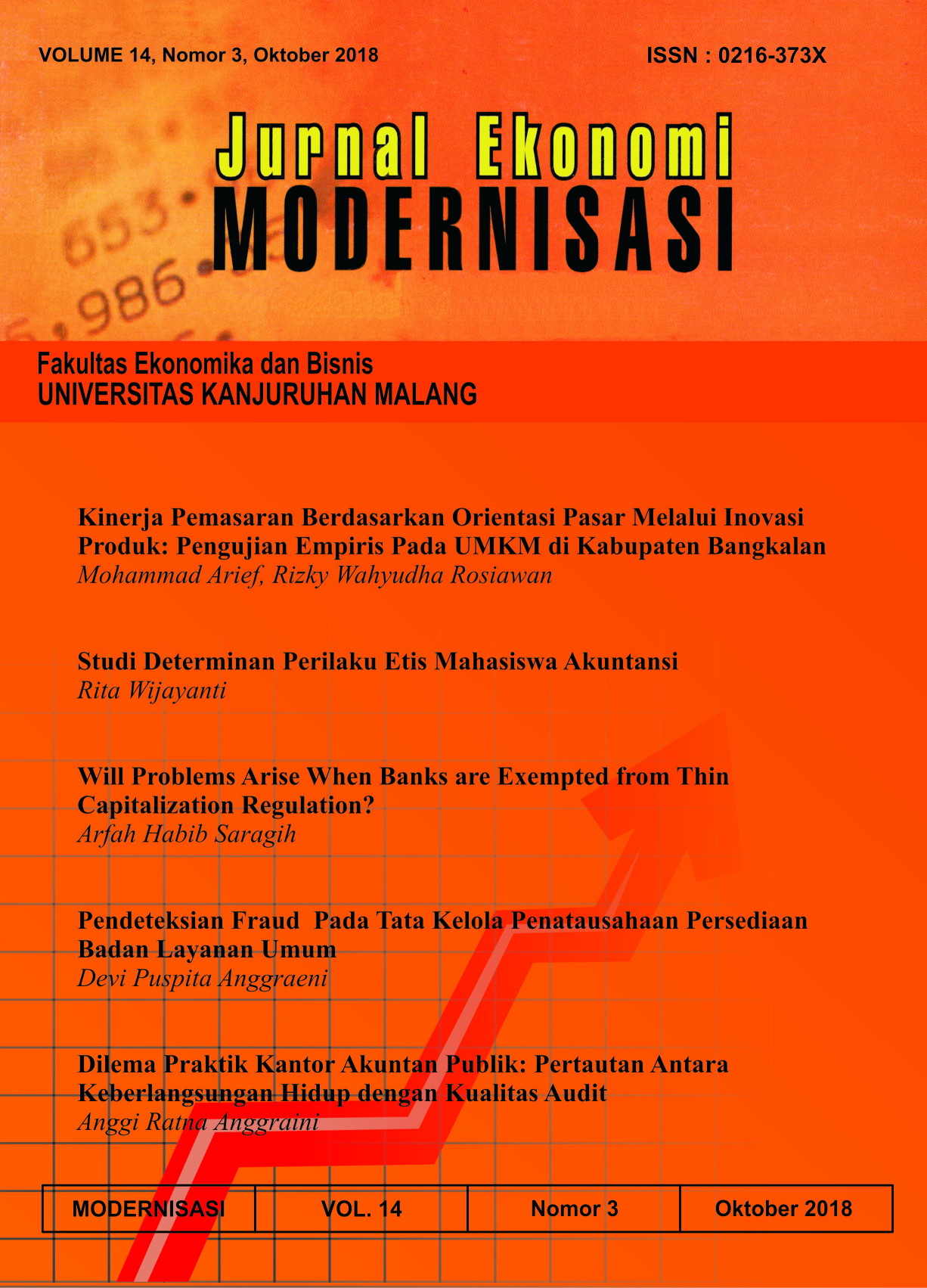Dilema Praktik Kantor Akuntan Publik: Pertautan Antara Keberlangsungan Hidup dengan Kualitas Audit
Main Article Content
Abstract
This research focuses on the dilemma of small Public Accounting Firms in maintaining their survival, but still maintaining their audit quality. This research is qualitative research with interpretive paradigm and the case study method. This study shows how Public Accounting Firm X faces a dilemma situation when auditing small clients with low fees, while maintaining their audit quality. Public Accounting Firm X in its survival growth strategy uses a "zebra", a "radar" and a business diamond strategy. Public Accounting Firm X itself has a dilemma when faced with a small client who can only pay a low fee for audit services, if using the indicator minimum hourly charge-out rates determined by IAPI, then the audit fee cannot be applied on the client. In the end, the audit procedures carried out must be adequate to maintain audit quality, where Public Accounting Firm X uses Excel based Standard Working Paper during audits and cuts the leveling level. Regulations that accommodate more smaller clients in the area are needed related to audit services.
Downloads
Article Details
Authors who submit a manuscript understand that if the manuscript is accepted for publication, the copyright of the article shall be assigned to Jurnal Ekonomi Modernisasi (JEM).
References
Adityasih, T. (2010). Analisis Pengaruh Pendidikan Profesi, Pengalaman Auditor, Jumlah Klien (Audit Capacity) dan Ukuran Kantor Akuntan Publik Terhadap Kualitas Audit. Thesis. Universitas Indonesia.
Burrell, G., & Morgan, G. (1979). Sociological Paradigms and organisational Analysis - Elements of the Sociology of Corporate Life. Routledge.
Carcello, J. V., & Nagy, A. L. (2004). Audit firm tenure and fraudulent financial reporting. Auditing, 23(2), 55–69.
Carpenter, M. A., Sanders, W. G. (2007). Strategic Management, A Dynamic Perspective: Concepts & Cases (2nd ed.). Upper Saddle River, NJ: Pearson Education.
Chow, C. W., & Rice, S. J. (1982). Qualified Audit Opinions and Auditor Switching. Source: The Accounting Review The Accounting Review, 57(2), 326–335.
Craswell, A. T., Francis, J. R., & Taylor, S. L. (1995). Auditor brand name reputations and industry specializations. Journal of Accounting and Economics, 20(3), 297–322. https://doi.org/10.1016/0165-4101(95)00403-3
DeAngelo, L. E. (1981). Auditor independence, “low ballingâ€Â, and disclosure regulation. Journal of Accounting and Economics, 3(2), 113–127. https://doi.org/10.1016/0165-4101(81)90009-4
Finlay, L. (2006). Going Exploring: The Nature of Qualitative Research, In Qualitative Research for Allied Health Professionals: Challenging Choices. New York: John Wiley & Sons Ltd
El-Gammal, W. (2012). Determinants of Audit Fees: Evidence from Lebanon. International Business Research, 5(11). https://doi.org/10.5539/ibr.v5n11p136
Hogan, C. E., & Jeter, D. C. (1999). Industry specialization by auditors. Auditing, 18(1), 1–17.
Allsop, D. T., Bassett, B. R., & Hoskins, J. A. (2007). Word-of-mouth research: Principles and applications. Journal of Advertising Research, 47(4). https://doi.org/10.2501/S0021849907070419
Institut Akuntan Publik Indonesia. (2018). Directory Kantor Akuntan Publik dan Akuntan Publik 2018. (http://iapi-lib.com/directory-2018, diakses Februari 2018)
Kanaka, A. (2010). Strategi Pertumbuhan Kantor Akuntan Publik (KAP) Kecil - Studi Kasus Pada KAP JAS. Tesis. Jakarta : Universitas Indonesia
Liao, Z., & Cheung, M.T. (2001). Internet-based E-Shopping and Consumer Attitude: an Empirical Study, Information and Management, 38, 229-306.
Lincoln, Y. S. & Guba E. G. (1985). Naturalistic Inquiry. Beverly Hills: California.
Moleong, L. J. (2011). Metodologi Penelitian Kualitatif Edisi Revisi. Bandung: PT Remaja Rosdakarya
Mustofa. (2014). Manajemen Modern Bisnis Kantor Akuntan. Jakarta : Kompas
Paranoan, N. (2015). Riset Non Positivistik Akuntansi dalam Tiga Paradigma: Interpretif, Kritis dan Postmodernisme. Jurnal Ilmiah Akuntansi dan Bisnis, 10(1), 8-18.
Republik Indonesia. (1995). Undang-undang Nomor 8 tahun 1995 tentang Pasar Modal. Lembaran Negara RI Tahun 1995, No. 64. Sekretariat Negara. Jakarta.
Republik Indonesia. (2011). Undang-undang Nomor 5 tahun 2011 tentang Akuntan Publik. Lembaran Negara RI Tahun 2011, No. 51. Sekretariat Negara. Jakarta.
Republik Indonesia. (2015). Peraturan Pemerintah Nomor 20 tahun 2015 tentang Praktik Akuntan Publik. Lembaran Negara RI Tahun 2015, No. 79. Sekretariat Negara. Jakarta
Simunic, D. A. (1980). The Pricing of Audit Services: Theory and Evidence. Journal of Accounting Research, 18(1), 161. https://doi.org/10.2307/2490397
Sukrisno, A & Husada, J. (2009). Bunga Rampai Auditing. Jakarta: Salemba Empat
Watkins, A. L., Hillison, W., & Morecroft, S. (2004). Audit quality: A synthesis of theory and empirical research. Journal of accounting literature, 23, 155-193.
Yin, R. K, (2009), Studi Kasus; Desain dan Metode, Jakarta; Raja Grafindo Persada.
Yin, R. K. (2015). Studi Kasus: Desain dan Metode. Jakarta: Rajawali Pers.
Yuniarti, R. (2011). Audit Firm Size, Audit Fee and Audit Quality. Journal Of Global Management, 2(1), 84-97.
